Introduction
Choosing the right AI blogging platform isn’t about picking the flashiest AI - it’s about shipping SEO-ready content consistently, ranking faster, and freeing your team from manual busywork. In this comparison, we put Blogbuster and Texta.ai head-to-head to help you find the best fit for your content engine in 2025.
"61.4% of marketers have integrated AI into their marketing activities." - Influencer Marketing Hub, AI Marketing Benchmark Report
Why this head-to-head matters in 2025
AI blogging comparison is no longer optional - if you’re not ranking, you’re invisible. Tools like Blogbuster and Texta.ai promise hands-free content pipelines, internal linking, and SEO automation to keep pace with search and AI overviews.
For SaaS teams and fast-moving startups, the difference between “generic AI posts” and human-sounding, interlinked, and localized articles can mean the difference between traffic spikes and flatlines.
This guide clarifies where each platform excels: daily SEO articles, auto-linking, localization, and publishing workflows - so you can scale content without sacrificing quality.
What you’ll learn (quality, SEO, workflow, pricing, and who each tool fits)
AI quality and brand voice: How human the content feels, and how well each adapts to your tone.
SEO engine: Keyword research, internal/external linking, structured elements, and SERP-readiness.
Workflow and UX: Topic ideation, editing, publishing, multi-site support, and localization.
Pricing and value: What you get at entry level, and where costs might creep.
Best fit by use case: Solo founders, lean marketing teams, agencies, and multilingual ops.
Comparison at a glance
One-table snapshot of core differences (focus, best for, key strengths, limits, starting price)
Tool | Focus | Best For | Key Strengths | Limits | Starting Price |
|---|---|---|---|---|---|
Blogbuster | Automated daily SEO articles with human-like tone, internal linking, and localization | Founders/marketers who want hands-off, SEO-ready blog posts and multi-language reach | Trend-driven topic ideas, auto internal linking, unique AI images, tables/markdown, built-in editor, 40+ markets with native tone, host or connect via API, automated backlink exchange | Pricing not publicly listed; output still benefits from editorial review; backlink exchange may not fit all industries | Not publicly listed (tiered plans available) |
Texta.ai | AI Blog Writer with auto-publishing, internal/external linking, and keyword research | SMBs and teams wanting hands-free blog and email content with GPT-4 quality | Autoblogging autopilot, automated SEO keyword research, internal/external linking, email writer, writing assistant, one-click CMS publishing | Visual/illustration features less emphasized; editorial polish recommended; pricing details vary by plan | 7-day free trial; paid plans available (pricing varies) |
How to read this guide (hands-on, replicable prompts, objective criteria)
Hands-on tests: We evaluate real workflows - topic → outline → draft → on-page SEO → publish - so you can replicate results.
Replicable prompts: We use consistent prompts for both tools across blog generation, interlinking, and on-page structure.
Objective criteria: We score on AI quality and tone fit, SEO features (keywords, links, structure), workflow speed, integrations/publishing, localization, and value. We also note where each excels or needs human polish to hit “publish-ready.”
Who each tool is for
Solo creators and bloggers
Blogbuster: Great if you want hands-off SEO posts that read human, with tables, internal links, and unique visuals baked in. Ideal for publishing consistently without heavy editing.
Texta: Strong for fast drafting and auto-publishing across common CMSs, with helpful email/newsletter add-ons if you also run audience comms.
SaaS and startup marketing teams
Blogbuster: Built for steady SEO growth - automated topic discovery, internal linking, and localization in 40+ markets to support product launches and feature updates.
Texta: Good fit for lean teams that need blog, email, and writing assistance in one place, plus autoblogging to keep the calendar full.
Agencies and content operations
Blogbuster: Suits multi-site management with auto internal linking, custom visuals, and structured outputs (tables/markdown). Helpful for scaling steady SEO content across clients.
Texta: Useful for teams that want autopublish workflows and assistants (blog + email) to move quickly across a wide range of content formats.
Compliance-heavy teams (accuracy, approval flows)
Blogbuster: Produces structured, referenceable drafts with on-brand tone; benefits from review layers in regulated spaces.
Texta: Practical for teams that want centralized generation for blogs and emails; still requires human QA for claims, references, and compliance notes.
Quick recommendations by persona
Want SEO articles that feel human and publish on autopilot? Choose Blogbuster.
Want a broader assistant that covers blogs and emails with quick CMS publishing? Choose Texta.
Scaling content across multiple sites/clients? Start with Blogbuster for structure and interlinking; add Texta if you need email support.
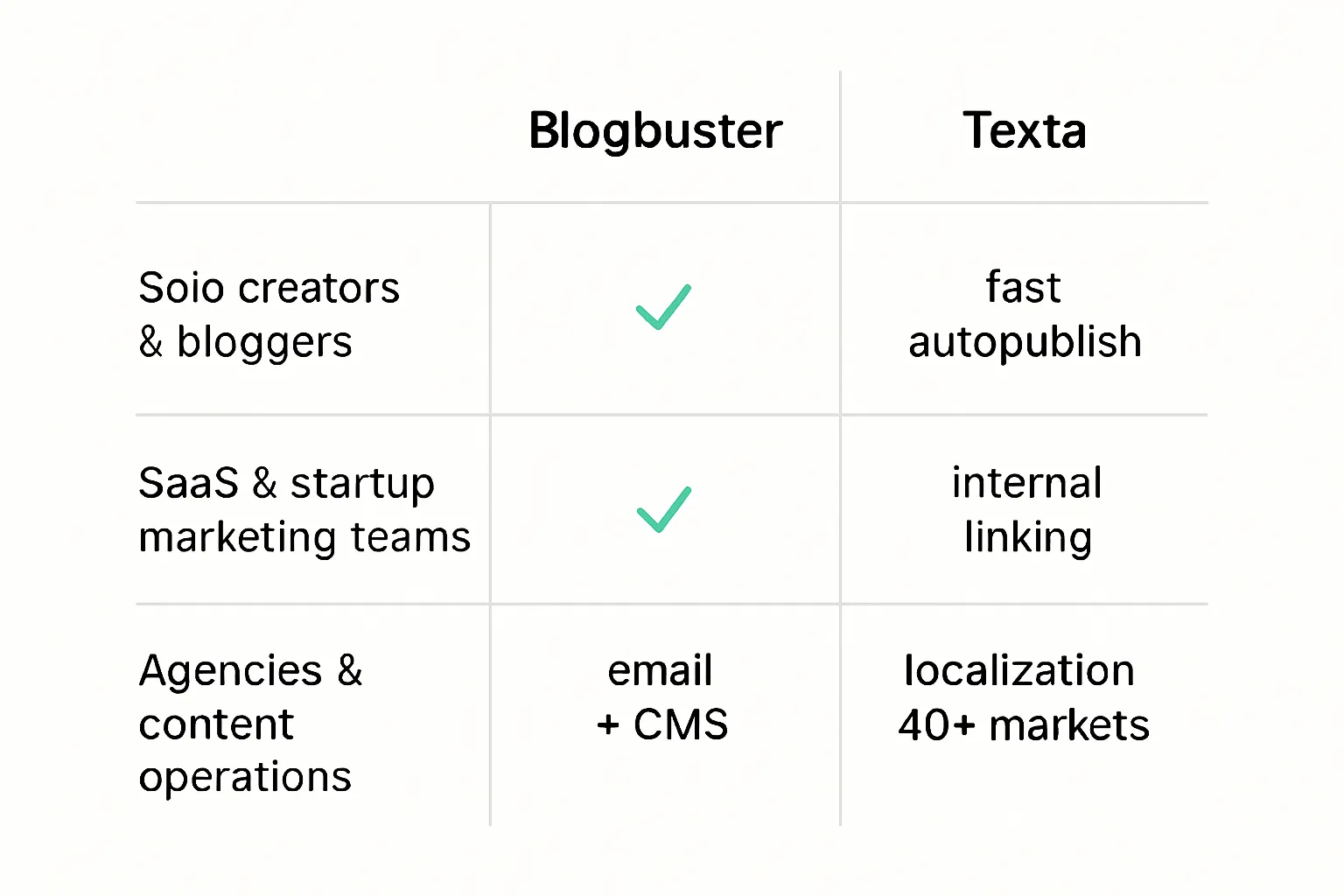
How we tested
Evaluation pillars (Content Quality, SEO Strength, Workflow & Collaboration, Integrations, Pricing/Value)
We scored each platform across five pillars:
Content Quality: Human-likeness, clarity, structure (headings, tables, lists), brand voice fit.
SEO Strength: Keyword targeting, internal/external linking, metadata, schema-like structure, readability.
Workflow & Collaboration: Topic ideation, outline to draft speed, editor UX, approvals, multi-site handling.
Integrations: Publishing to CMSs, API flexibility, localization support, asset handling (images, tables).
Pricing/Value: Output volume vs. cost, included automation, and expected editing overhead.
The content types we generated (1 blog post, 1 social set, 1 email, SEO elements)
Blog post: 1,200–1,500 words targeting a transactional long-tail keyword; included table, key takeaways, and FAQ.
Social set: 5-post LinkedIn set repurposed from the blog’s angles; clear hooks, value-first copy.
Email: Newsletter-style announcement promoting the blog; concise, skimmable, CTA-driven.
SEO elements: Title tags, meta descriptions, H2/H3 hierarchy, internal link suggestions, and anchor text.
The exact prompts we used (blog, social, email)
Blog prompt: “Write an SEO-focused blog post on [primary keyword] for [audience]. Tone: [brand voice]. Include: compelling intro, scannable subheads, a comparison table, internal link opportunities, key takeaways, and a short FAQ. Target word count: 1,300. Optimize for readability and conversions.”
Social prompt: “Create 5 LinkedIn posts repurposed from the blog. Each post should include: a strong hook, 2–3 crisp insights, and a soft CTA to learn more. Avoid emojis, keep to 80–120 words, and vary angles (myth-busting, quick tips, mini case insight, checklist, and question-led).”
Email prompt: “Draft a concise newsletter promoting the new blog on [topic]. Subject line: 6–8 words, curiosity-led. Body: 120–160 words, skimmable bullets, one primary CTA, maintain [brand voice], and avoid spammy phrasing. Include a P.S. with an alternate angle.”
Scoring rubric (1–5 for each pillar)
1 = Needs heavy editing; limited automation; low SEO readiness.
2 = Basic output; requires significant polish; partial SEO support.
3 = Competent drafts; decent SEO features; workable workflow.
4 = Strong drafts with human feel; robust SEO; smooth publishing.
5 = Publish-ready quality; advanced SEO automation; efficient end-to-end workflow.
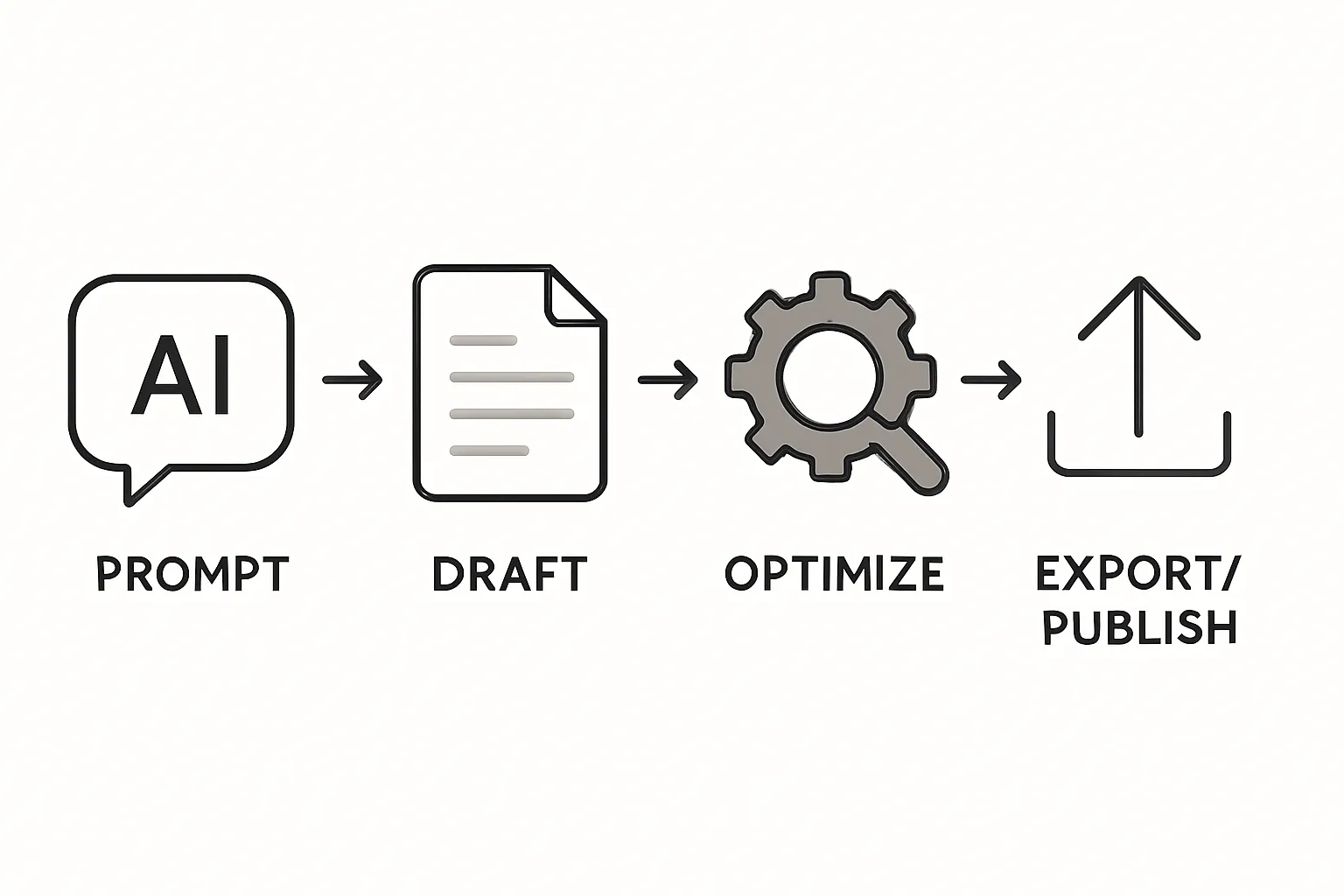
AI writing quality and SEO depth
Outline quality and factuality (headlines, flow, hallucination checks)
Blogbuster creates structured outlines with scannable H2/H3s, embeds comparison tables, and inserts FAQs and key takeaways. Drafts aim for human tone and can reference provided source docs to reduce hallucinations.
Texta.ai generates coherent outlines quickly and supports long-form drafting. Factuality improves when you guide inputs and review external link suggestions.
On-page SEO tools (keywords, headers, meta, internal links)
Blogbuster: Built-in keyword/topic discovery, auto internal linking, SEO-friendly structures (tables, bullets), and localization-aware keywords across 40+ markets.
Texta.ai: Automated keyword research plus internal and external linking; meta elements and headers can be produced alongside drafts.
Brand voice controls and style consistency
Blogbuster adapts to brand tone and audience with on-brand formatting and consistent sectioning patterns for series.
Texta.ai maintains a clear, professional voice with options to adjust tone; excels when paired with your brand guidelines.
Readability and engagement (hooks, examples, CTAs)
Blogbuster: Strong hooks, section intros, and skimmable lists; adds unique visuals to break walls of text and includes CTAs naturally.
Texta.ai: Clear structure and pace; benefits from brief human edits to add specific examples and brand anecdotes.
Export fidelity (Docs/HTML/WordPress)
Blogbuster outputs clean HTML/Markdown with tables and images intact; can host or publish via API to major platforms.
Texta.ai offers one-click CMS connections (e.g., WordPress/Webflow/Shopify/Wix) for streamlined publishing.
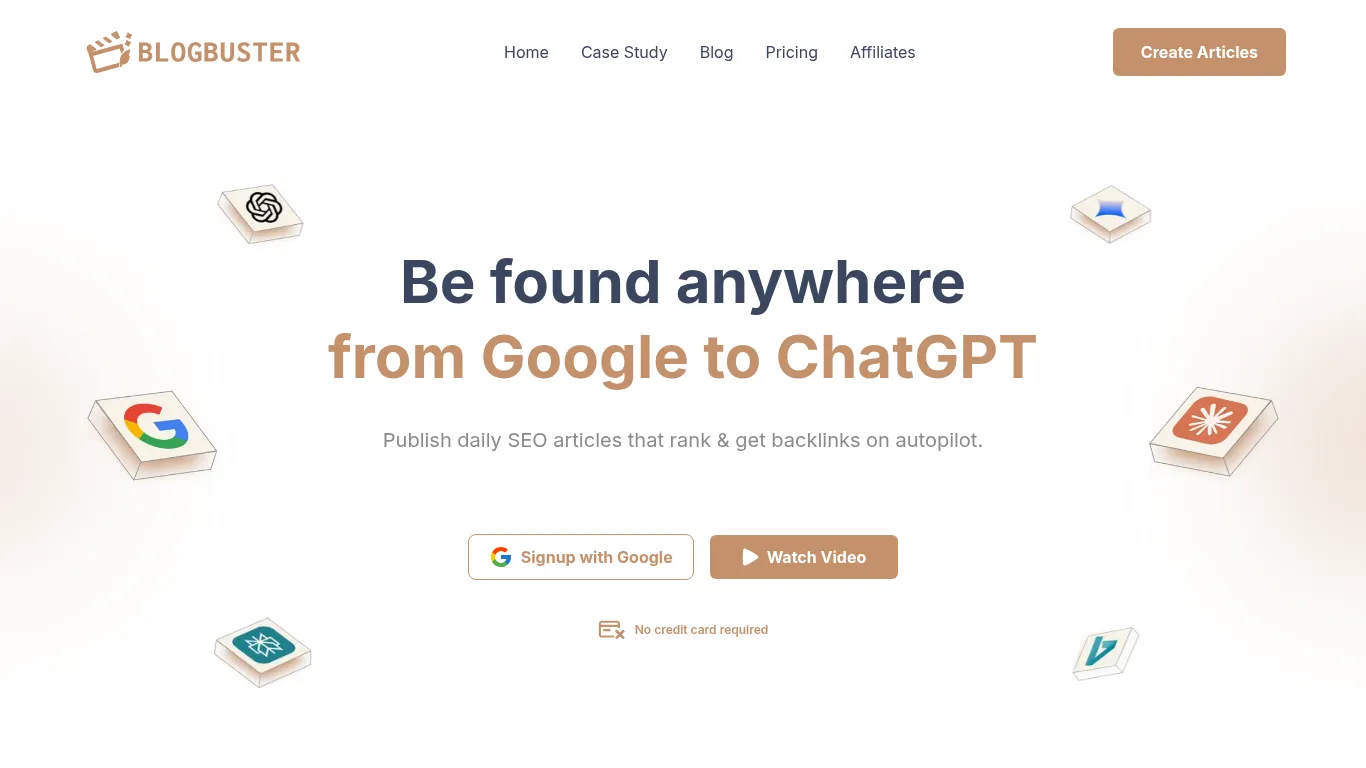
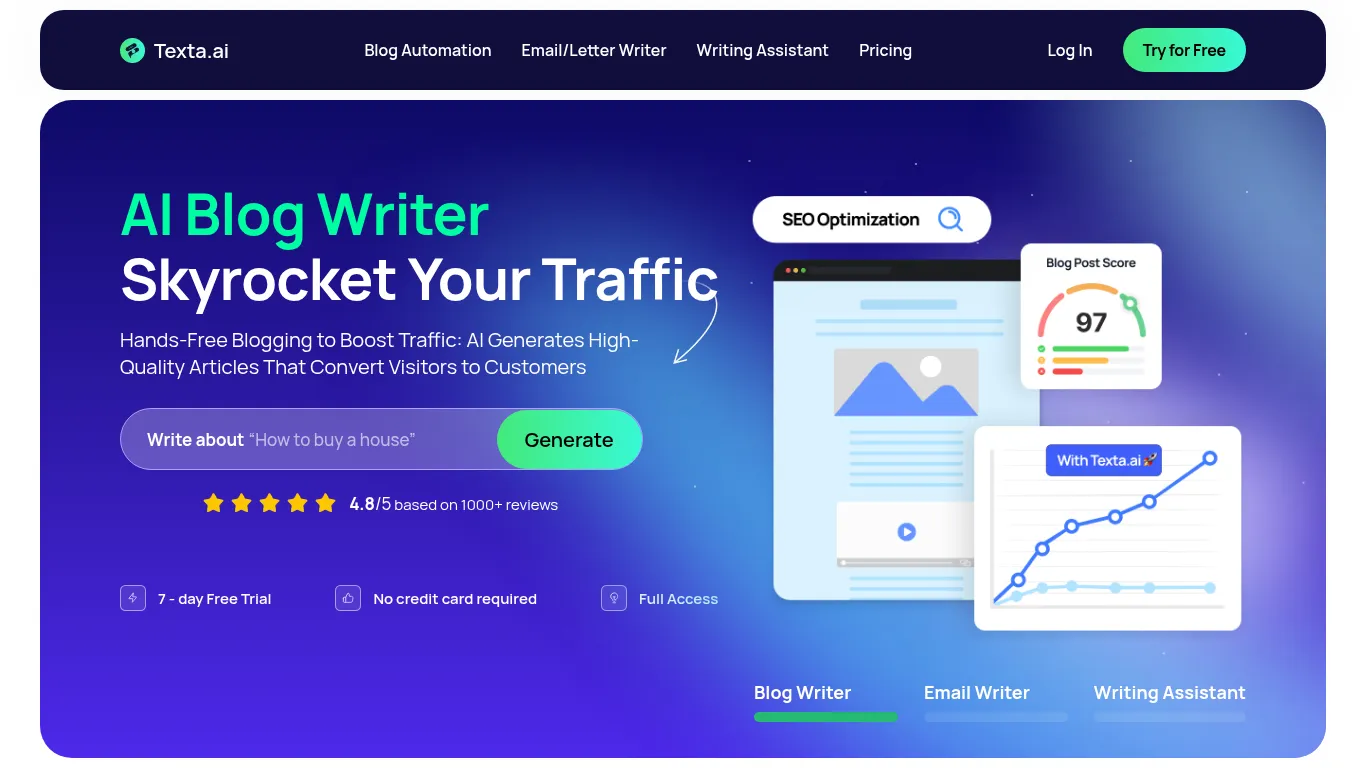
Verdict for this pillar
Blogbuster is better for SEO depth out of the box (internal linking, structured elements, localization, and custom visuals).
Texta.ai wins on breadth with integrated keyword research and CMS publishing; add light editing to reach a more human, example-rich tone.
Pillar | Blogbuster | Texta.ai |
|---|---|---|
Outline & factuality | Strong, with table/FAQ patterns and source references | Good; benefits from guided inputs |
On-page SEO | Excellent auto internal linking and localized keywords | Robust keyword research + linking |
Brand voice | Adaptive and consistent across series | Clear tone; improves with guidelines |
Readability | Skimmable, visuals included, CTA-ready | Structured; add examples for lift |
Export fidelity | Clean HTML/Markdown + API/hosting | One-click CMS connections |
Automation, workflow, and publishing
Content calendar, scheduling, and bulk generation
Blogbuster: Prioritizes steady volume with daily SEO articles, trend-driven topic ideas, and automated backlink exchange. Supports multi-article runs and instant hosting or API publishing.
Texta.ai: Autoblogging and scheduling features help keep a consistent cadence. Bulk generation for drafts and queueing across connected blogs.
Collaboration (roles, approvals, versioning)
Blogbuster: Built-in editor for fast on-brand tweaks before publishing; fits simple approval flows for lean teams.
Texta.ai: Team-friendly for drafting and refining across blogs and email; add review layers to standardize tone and claims.
CMS and site integrations (WordPress, Webflow, Notion, Docs)
Blogbuster: Host on-platform, connect to existing sites, or use API for custom stacks; exports clean HTML/Markdown with visuals and tables intact.
Texta.ai: One-click connections to popular CMSs (e.g., WordPress, Webflow, Shopify, Wix) and streamlined publishing from draft to live.
Auto-optimization steps (links, media embeds, schema where applicable)
Blogbuster: Auto internal linking, unique AI images, tables, localized keywords, and CTA-ready sections - minimizing manual SEO chores.
Texta.ai: Automated internal/external linking, keyword research, and meta elements; media embedding supported within the draft workflow.
Multisite or client management (for agencies)
Blogbuster: Manage several projects/domains from one dashboard; strong for agencies needing structure, interlinking, and localization at scale.
Texta.ai: Connect multiple blogs and use automation to keep content moving across clients and formats (blogs + emails).
Verdict for this pillar
Blogbuster is best if you want a reliable “idea-to-publish” pipeline with strong SEO automation, internal linking, and hosting/API flexibility - especially for multi-market or multi-site setups.
Texta.ai is best if you need broader content operations spanning blogs and email with simple, fast CMS connections and queue-based scheduling.
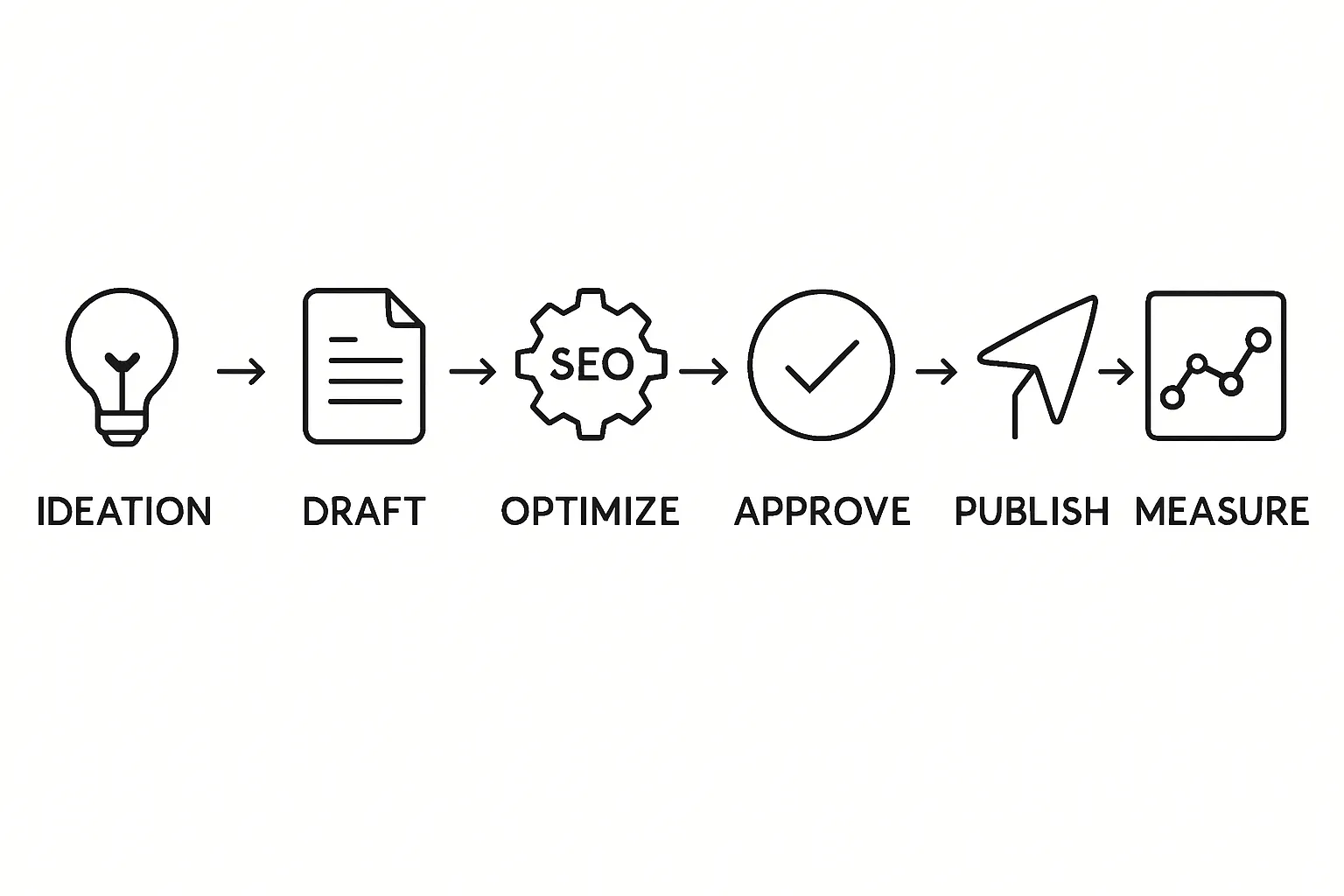
Templates, long‑form editor, and extras
Template coverage (blogs, product pages, emails, ads, social) and customization
Blogbuster: Template set is laser‑focused on blogs. You get top‑class blog templates with tables, bullets, meta elements, and CTAs pre-wired for readability and SEO. Customization spans tone, structure, and formatting; strong fit if your priority is “publishable blog content” versus a broad template library for ads or landing pages.
Texta.ai: Broader coverage beyond blogs thanks to its AI Blog Writer, Email Writer, and Writing Assistant. Useful if your content ops span blog + email and you want template-driven speed. Customization is prompt-led with adjustable tone and structure.
Long‑form editor capabilities (outline lock, section rewrite, live scoring)
Blogbuster: Built-in editor for on-brand tweaks, section rewrites, and quick formatting adjustments. Output ships with structured sections (H2/H3s, FAQs, key takeaways) and comparison tables. Emphasis is on automation (topic → draft → internal links) over heavy in-editor scoring widgets.
Texta.ai: Streamlined drafting experience with auto-publishing to popular CMSs. Strong for turning prompts into long-form drafts and refining sections; prioritizes fast iteration rather than granular live SEO scoring within the editor.
Media assist (images, video embeds), plagiarism check, and multilingual support
Blogbuster: Generates unique AI images per article, supports embedded media, and formats visuals for scannability. Multilingual at scale (40+ markets) with native tone, local keywords, and cultural nuances - beyond basic translation. No native plagiarism checker advertised.
Texta.ai: Media can be embedded in the draft workflow and external links added automatically; focus is on content speed and CMS handoff. Multilingual support isn’t a headline feature on the homepage. No native plagiarism checker advertised.
Knowledge ingestion/brand guidelines (if available)
Blogbuster: Adapts to your brand’s tone and can incorporate references to key documents/topics to nudge factuality and style. Good for series consistency across posts.
Texta.ai: Maintains a consistent tone and style via prompts and assistants (not positioned as deep knowledge ingestion). Best results come from providing examples and simple brand notes up front.
Verdict for this pillar
Choose Blogbuster if your priority is high-quality blog templates, human-like long‑form, unique AI visuals, auto internal linking, and true multilingual execution across 40+ markets.
Choose Texta.ai if you need broader templates across blog and email plus fast CMS-ready drafts and simple refinement loops.
If you ultimately want an all-in-one blog platform with fast SEO templates, built-in newsletter, and analytics - so you can launch in minutes and scale without extra tools - consider BlogBowl for your long‑term content hub.
Pricing and value for money
Plans overview and word/seat limits
Both platforms use tiered plans aimed at different production volumes. Blogbuster’s tiers are article-count based (10/30/60 per month), while Texta.ai emphasizes automation for blogs and emails with a 7-day free trial before paid plans.
What’s included at entry vs. growth tiers
Entry tiers focus on getting consistent posts out the door with SEO basics; growth tiers unlock more sites, more posts, and more automation (like internal/external links and localization).
Hidden costs to watch (add‑ons, overages, seats)
Watch for volume overages, extra sites, additional images/regenerations, and extra seats if your team scales. Factor in editorial time - automation saves effort, but human QA still matters.
Value by persona (solo, team, agency)
Solo: Choose the lowest tier that covers expected monthly posts; prioritize autopublish and internal linking.
Team: Weigh collaboration needs, CMS integrations, and localization.
Agency: Prioritize multi-site management, structured outputs, and automation that reduces per‑post labor.
Tool | Entry Tier (focus) | Entry Limits (approx.) | Growth Tiers (focus) | Growth Limits (approx.) | Notable Inclusions | Hidden Costs To Watch | Best Value For |
|---|---|---|---|---|---|---|---|
Blogbuster | Hands-off SEO blogging | ~10 SEO articles/mo; 1 connected site; automated internal linking; structured outputs (tables, bullets) | Scaling SEO output | ~30 or ~60 SEO articles/mo; up to 3–5 connected sites; automated internal linking; backlink exchange (5–10/mo by tier) | Trend-based topic ideas, unique AI images, localization in 40+ markets, clean HTML/Markdown, API/hosting | Extra image regenerations beyond free allotment; higher volumes; additional connected sites | Agencies and teams needing structured SEO, auto internal linking, localization, and multi-site ops |
Texta.ai | Blog + email foundations | 7‑day free trial; paid plans follow (limits vary by plan) | Autoblogging at scale | Autopublishing to CMS; internal/external linking; keyword research (limits vary) | One-click CMS connections (e.g., WordPress/Webflow/Shopify/Wix), email writer, writing assistant | Potential overages for volume/words; extra seats; automation usage | Solos/teams who want blog + email automation and simple CMS handoff |
Verdict for this pillar
Best cost-efficiency for SEO-heavy scaling: Blogbuster (clear article-based tiers, internal linking automation, localization, and visuals reduce downstream editing costs).
Best breadth for mixed workloads (blog + email) and fast CMS publishing: Texta.ai (trial-first approach helps validate fit before scaling).
If you want transparent, long‑term value with a full content hub - fast SEO templates, built‑in newsletter, and analytics - BlogBowl is designed to replace multiple tools and simplify total cost of ownership.
Security, data ownership, and compliance
Data usage and retention (training policies, private mode)
Confirm whether your prompts, drafts, and published posts are excluded from model training by default or only in “private”/enterprise modes.
Ask for a clear data retention window (e.g., 30–90 days for logs), where data is stored (region-level residency), and whether you can request deletion at the project level.
Require a signed DPA, GDPR/CCPA alignment, and a transparent subprocessors list.
"93% of creators say AI helps them produce faster when guardrails are in place." - Source
User roles, SSO/SAML, permissions
Look for role-based access (writer, editor, approver, admin), audit logs, and content locks for approval steps.
For larger teams, SSO/SAML and SCIM user provisioning reduce risk and simplify onboarding/offboarding.
Enforce least-privilege by project/domain, including export and publish permissions.
Content originality and AI detector considerations
Use plagiarism checks and citation workflows for claims; keep an internal policy for verifying statistics and brand-sensitive statements.
AI detectors are imperfect - prioritize originality signals (unique structure, internal links, custom visuals, localized nuance) rather than detector scores alone.
Maintain a revision history and keep sources attached to the draft for audits.
Industry compliance needs (legal, healthcare, finance)
Require approval queues with frozen templates, redlines, and sign-offs for regulated content.
Ensure PII/PHI filters and external link controls; disable public model training and enable project-level data isolation.
Ask vendors for security attestations (SOC 2, ISO 27001) and incident response SLAs; verify data export for eDiscovery.
Verdict for this pillar
For most teams, the critical factors are DPA + retention controls, role-based permissions, and documented approval flows. Validate these before migrating your content pipeline.
In compliance-heavy environments, prioritize vendors offering private-mode processing, SSO/SAML, granular approvals, and region-based data residency - plus auditable revision history and export options.
Alternatives and when to consider BlogBowl
When Blogbuster makes the most sense
You want an SEO-first blog machine with daily articles, auto internal linking, and human-like long‑form that ships consistently.
You value localization across 40+ markets with native tone and localized keyword choices.
You prefer structured outputs (tables, bullets, FAQs) and clean HTML/Markdown or API handoff.
When Texta.ai makes the most sense
You want a broader assistant that covers blog + email, with autopublishing to common CMSs and quick iterations.
You need automated internal/external linking plus keyword research inside the drafting workflow.
You’re prioritizing a fast start via a trial to validate volume/cadence before scaling.
Where both fall short (common gaps)
Deep publishing stack (hosting + blazing-fast SEO templates + analytics + newsletter) under one roof.
Multi-author newsletter and blog analytics unified in one dashboard, without third‑party stitching.
Opinionated safeguards for compliance-heavy approvals (SAML/SSO, audit logs) may require workarounds.
When BlogBowl is a better fit
All‑in‑one blog stack (hosting, blazing‑fast SEO templates, newsletter)
Launch in ~60 seconds with fast, SEO-ready templates that rank in Google and AI search.
Built-in newsletter and CTA blocks; no extra tools to manage.
Heavy automation (daily SEO posts, internal linking, keyword research, AI images/video embeds)
Automated, human-sounding articles, internal links, and embedded media - publish on autopilot.
Multisite/client management + analytics baked in
Unlimited blogs, changelogs, and help docs across custom domains with privacy-friendly analytics.
Quick migration or “run alongside” ideas (use BlogBowl as the publishing engine)
Keep ideating in your current tool but publish via BlogBowl for speed, SEO templates, and analytics.
Pipe drafts from Blogbuster or Texta into BlogBowl’s editor for internal linking and embedded media polish.
Stand up a new market/country blog in BlogBowl to test localized growth without touching your main site.
Try-before-you-buy checklist
Can you launch a working blog (domain, template, analytics, newsletter) in under 5 minutes?
Do drafts include internal links, CTAs, and embedded media without manual wrangling?
Can you manage multiple blogs and authors from one dashboard with clean analytics?
Is the output fast, SEO-optimized, and consistent with your brand voice out of the box?
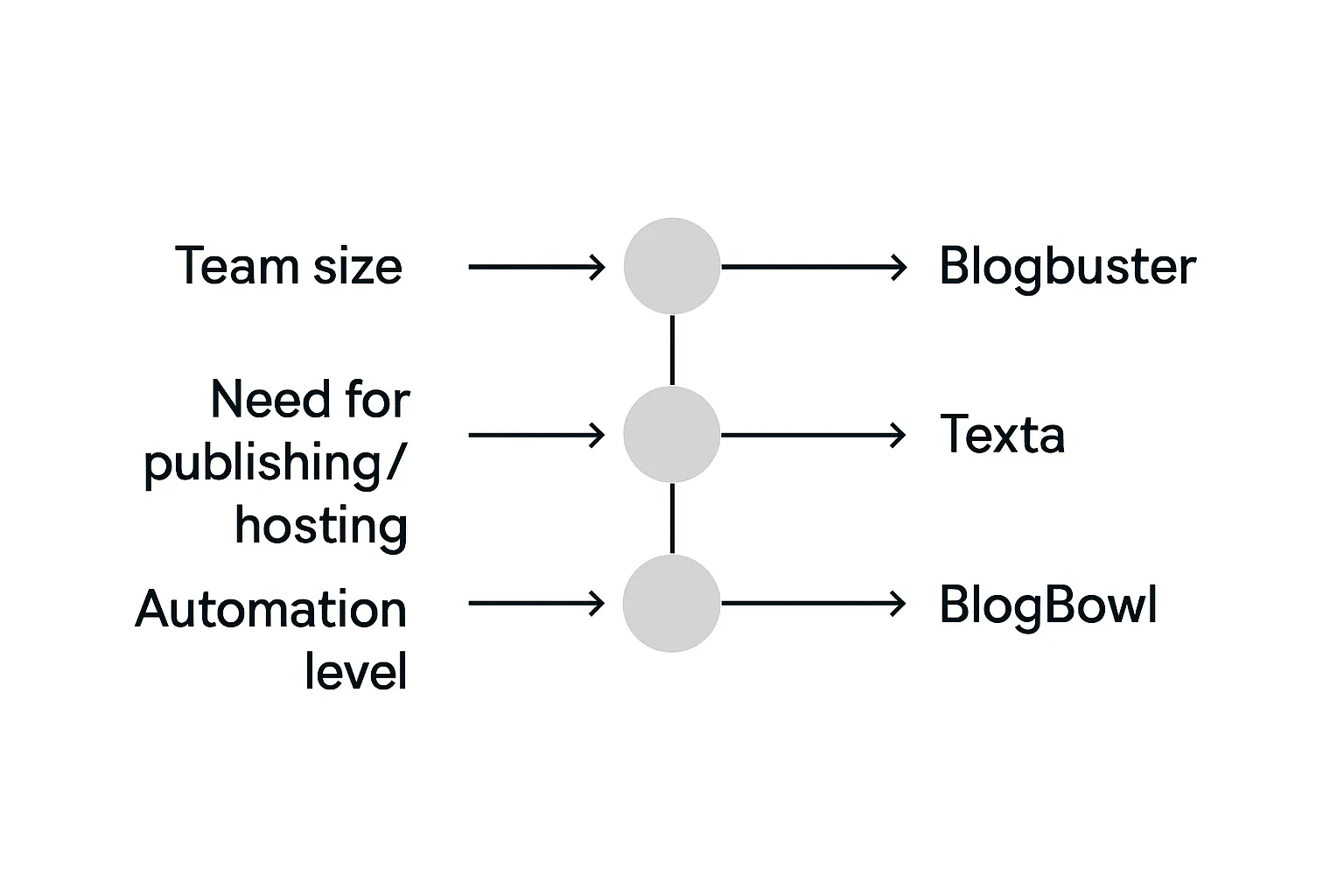
Final verdict
TL;DR picks by scenario
Fast blog-focused production with SEO workflows → pick Blogbuster. It excels at daily, human‑sounding SEO articles, internal linking, and structured outputs that ship fast.
Broad, multi-format copywriting with templates → pick Texta.ai. It’s strong for blog + email + assistant workflows, quick CMS publishing, and keyword research inside the draft.
Need a zero‑maintenance blog that publishes itself and grows SEO on autopilot → consider BlogBowl. It’s an all‑in‑one stack with blazing‑fast SEO templates, built‑in newsletter, analytics, automated long‑form creation, internal linking, and embedded media - so you can launch in minutes and scale without extra tools.
What to test in your 7‑day trial (checklist)
Content quality and tone fit
Do first drafts sound human and on-brand with minimal prompts?
Are outlines logical with skimmable H2/H3s, tables, and FAQs?
SEO depth
Does it suggest keywords, add internal links, and generate clean meta?
How good are localization and intent targeting for long‑tail queries?
Workflow speed
Can you go from idea → outline → draft → publish in under 30 minutes?
Does bulk generation keep quality stable across multiple posts?
Publishing and integrations
Is HTML/Markdown clean and CMS‑ready?
Are one‑click connections and/or API reliable for your stack?
Collaboration and governance
Roles, approvals, versioning, and auditability - are they simple and safe?
Analytics and iteration
Can you track performance and quickly repurpose posts to email/social?
Next steps and links
Shortlist two tools and run the same prompts across both for one week. Score them on quality, SEO, speed, and publishing reliability.
If you want the simplest way to launch and scale a professional blog (with newsletter and analytics baked in), try BlogBowl: https://www.blogbowl.io
Tip: Keep your prompts, outlines, and scoring rubric identical across tools - that’s the fairest AI blogging comparison and makes your winner obvious.


